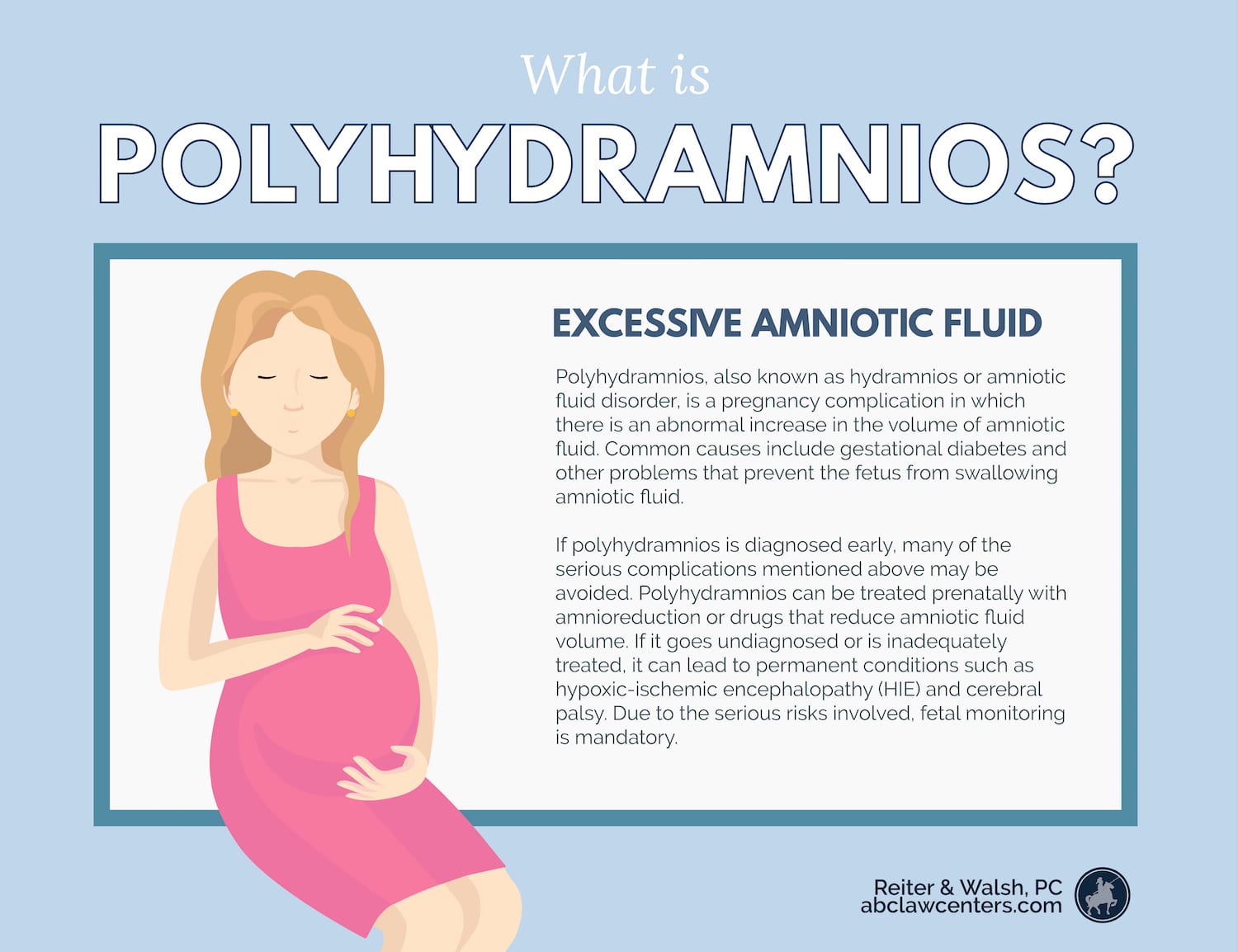Polyhydramnios (Excessive Amniotic Fluid)
What is polyhydramnios?
Polyhydramnios is a pregnancy complication in which there is an abnormal increase in the volume of amniotic fluid. It is also known as hydramnios or amniotic fluid disorder.
When the uterus seems unusually large, doctors should check for polyhydramnios. They can measure amniotic fluid volume through ultrasounds.
There are not always symptoms for polyhydramnios. Symptoms can include:
- Difficulty breathing or shortness of breath
- Abdominal discomfort
- Uterine contractions or irritability
- Larger than normal abdomen on exam

Medical malpractice and polyhydramnios
If a condition like polyhydramnios is not managed properly, harm can come to your baby. You should be able to trust the medical professionals around you to account for complications during pregnancy. Otherwise, your child may develop permanent disabilities, like hypoxic-ischemic encephalopathy, cerebral palsy, or developmental delays.
If you have any uncertainty surrounding your child’s birth, talk to one of our attorneys today. We are here to answer any questions you may have about your child’s birth injury.
About amniotic fluid
Amniotic fluid surrounds the baby during pregnancy. While the baby grows, the baby swallows amniotic fluid. The baby’s kidneys produce more fluid which the baby urinates into the womb.
Amniotic fluid also:
- Provides cushioning/protection for the growing infant
- Allows the infant to move about in the womb, which helps with bone and muscle growth
- Promotes lung development
- Regulates temperature in the womb
What causes Polyhydramnios?
Polyhydramnios, an excess of amniotic fluid, occurs in about 1% of pregnancies. It is the opposite of oligohydramnios, a condition with too little amniotic fluid. Some of the most common causes of polyhydramnios are as follows:
- Maternal diabetes: Diabetes, including gestational diabetes, can lead to amniotic fluid build up.
- Fetal anomalies: Problems with swallowing or digestion can prevent a baby from swallowing enough amniotic fluid.
- A multiple pregnancy (twins, triplets)
- Genetic causes
- Twin to twin transfusion syndrome (TTTS): In some twin pregnancies, blood from one twin goes to the other. This can result in polyhydramnios and medical problems for both twins.
- Incompatible blood types: If the mother has a positive blood type and the baby has a negative blood type, the baby can develop a type of anemia. This can cause polyhydramnios.
- Fetal heart conditions: This could include a congenital defect or another irregularity with the baby’s heart rate.
- Macrosomia: when the baby is large for gestational age
What are the risks of polyhydramnios?
The largest risks of polyhydramnios are preterm birth and emergencies during labor and delivery. If these complications are not managed properly, the baby can develop permanent injury like hypoxic-ischemic encephalopathy or cerebral palsy.
Medical staff can diagnose polyhydramnios early and avoid serious complications. Prenatal treatments can reduce the amount of amniotic fluid.

It is difficult to cope with a birth trauma diagnosis, especially if it was caused by a mismanaged condition like polyhydramnios. You should be able to trust your doctors to monitor and treat complications during pregnancy.
If your child has a diagnosis like hypoxic-ischemic encephalopathy, cerebral palsy, or a seizure disorder, medical malpractice may have been involved.
Our team is deeply familiar with circumstances around birth injury. Call us now to share your story and find out your legal options.
Complications of polyhydramnios
Polyhydramnios can cause serious complications in a pregnancy. The swelling of the uterus leads to complications including:
- Maternal breathing difficulties
- Preterm labor
- Premature rupture of membranes (PROM)
- Unusual fetal presentation
- Umbilical cord prolapse
- Postpartum hemorrhage
- Placental abruption
Tell us your story.
Complications from a birth injury can be difficult and confusing. Our attorneys at ABC Law Centers: Birth Injury Lawyers focus specifically on birth injury cases and are happy to answer any questions you may have.
Diagnosis of polyhydramnios
An ultrasound can indicate the amount of amniotic fluid and help diagnose polyhydramnios. If medical professionals suspect polyhydramnios, they may also perform the following tests:
- Amniocentesis: This is a way of sampling amniotic fluid to test for genetic conditions that may contribute to polyhydramnios.
- Doppler ultrasound: This is a type of ultrasound that can take images of the fetus’s circulatory system.
- Glucose challenge test: This test is for women with diabetes.
- Non-stress test: This is a means of checking for abnormalities in the fetal heart rate
Treatments and medical interventions for polyhydramnios
Mild cases of polyhydramnios may not require treatment. Doctors should have their patients come in for extra prenatal checkups to monitor the condition and make sure it does not become severe.
Additional treatments for polyhydramnios include:
- Amnioreduction: This treatment involves using a long needle to drain excess amniotic fluid from the uterus. There are certain risks associated with this procedure. Doctors must weigh the risks and talk to the patient when deciding whether it is an appropriate intervention.
- Medications to reduce the amount of fetal urine: This medication can put the fetus’s heart health at risk. Doctors must be careful in determining whether this is the right path. They must also carefully monitor the baby for signs of fetal distress.
- Early induction
- Bed rest: This can help delay preterm labor in cases of moderate polyhydramnios


Long-term outcomes and legal help
If polyhydramnios is not promptly diagnosed and treated, it can lead to serious birth injuries. The child may have disabilities like hypoxic-ischemic encephalopathy, cerebral palsy, and seizure disorders.
Birth injury is a difficult area of law to pursue due to the complex nature of the medicine. The award-winning attorneys at ABC Law Centers: Birth Injury Lawyers focus exclusively on these cases. We have had the privilege to secure multi-million dollar verdicts and settlements for children like yours.
To find out if you have a case, contact our firm to speak with one of our lawyers. No fees are ever paid to our firm until we win your case.
We are here for your family. Call and speak with an attorney whenever you’re ready.
Featured Videos
Posterior Position
Hypoxic-Ischemic Encephalopathy (HIE)

Featured Testimonial
What Our
Clients Say…
After the traumatic birth of my son, I was left confused, afraid, and seeking answers. We needed someone we could trust and depend on. ABC Law Centers: Birth Injury Lawyers was just that.
- Michael
Helpful resources
Hamza, A., Herr, D., Solomayer, E. F., & Meyberg-Solomayer, G. (2013). Polyhydramnios: causes, diagnosis and therapy. Geburtshilfe und Frauenheilkunde, 73(12), 1241-1246.
2. Polyhydramnios: MedlinePlus Medical Encyclopedia. (n.d.). Retrieved February 6, 2019, fromhttps://medlineplus.gov/ency/article/003267.htm
3. Polyhydramnios: High Amniotic Fluid During Pregnancy. (2017, June 25). Retrieved from http://americanpregnancy.org/pregnancy-complications/polyhydramnios-high-amniotic-fluid/
4. UpToDate | Polyhydramnios: Etiology, diagnosis, and management in singleton gestations


